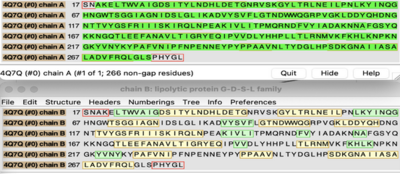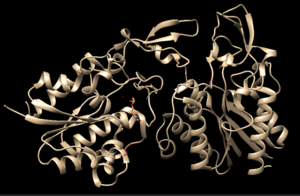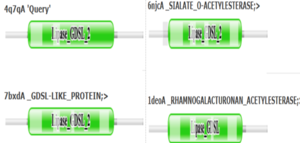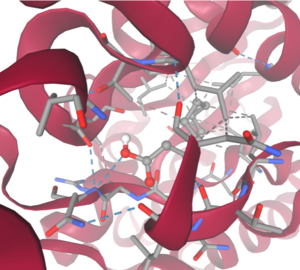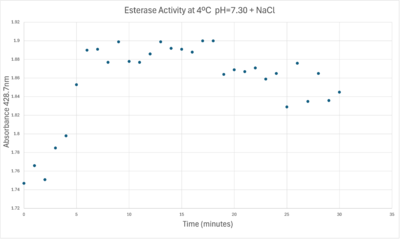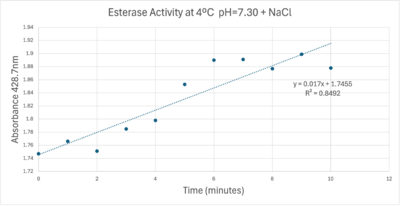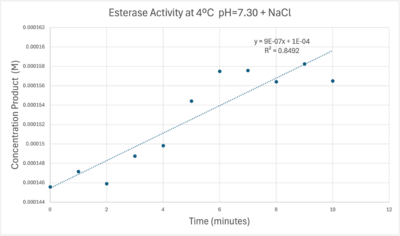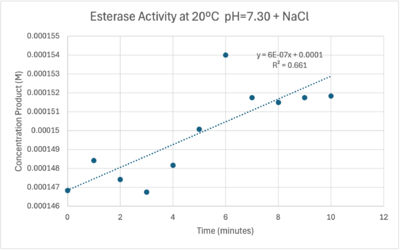Sandbox323
From Proteopedia
(Difference between revisions)
(New page: ==Your Heading Here (maybe something like 'Proposed Function of 4DIU')== Think of this like an abstract. Include a few sentences about the most important data you found about what type of...) |
|||
| (100 intermediate revisions not shown.) | |||
| Line 1: | Line 1: | ||
| - | == | + | ==Structural Analysis and Proposed Functionality of 4Q7Q== |
| - | + | 4Q7Q is a homodimeric protein complex that originates from the bacterial species Chitinophaga Pinensis and has a mass of 58.5 kDa. It is a member of the SGNH Hydrolase Superfamily with structural and sequential similarities to esterases and lipases. Current evidence suggests it causes the hydrolysis of esters and/or acetyl groups on lipids/lipid-like molecules via a catalytic triad-like active site. | |
| - | <StructureSection load=' | + | <StructureSection load='4Q7Q' size='200' side='right' caption='3D Representation of 4Q7Q's structure' scene=''> |
| - | + | ||
| - | + | ||
| - | == Overview | + | == Overview == |
| - | + | === General Structure and Origins === | |
| + | 4Q7Q exists as a homodimer Quaternary structure.<ref name="Sequence">4Q7Q. Protein Database, 2014. https://www.rcsb.org/structure/4Q7Q</ref> Analyzing primary and Quaternary structures of 4Q7Q with SPRITE revealed two chains identical in both shape and sequence<ref name="SPRITE">Nadzirin, N.; Gardiner, E.; Willett, P.; Artymiuk, P. J.; Firdaus-Raih, M. 2012. SPRITE and ASSAM: web servers for side chain 3D-motif searching in protein structures. Nucleic Acids Res., 40(Web Server Issue), W380-6.</ref> Each chain is 266 residues long, and the entire complex has a molecular weight of approximately 58.5 kDa.<ref name="Sequence" /> | ||
| - | = | + | [[Image:4Q7QABSequence.png|400px|left|thumb| Primary Sequences of the A and B chains of 4Q7Q.<ref name="SPRITE" />.]] |
| - | + | 4Q7Q proteins primarily appear in bacterial species.<ref name="Origin">Rio, T. G. D.; et al. Complete genome sequence of Chitinophaga pinensis type strain (UQM 2034). Stand. Genomic. Sci., 2010, 2(1), 87-95. https://pmc.ncbi.nlm.nih.gov/articles/PMC3035255/</ref>. Research reveals how nearly every enzyme with similar sequencing to 4Q7Q is found in bacterium, with a slight exception to eukaryotes.<ref name="SGNH">SGNH hydrolase superfamily. InterPro, 2017. https://www.ebi.ac.uk/interpro/entry/InterPro/IPR036514/</ref> Additionally, the PDB entry for 4Q7Q notes how it potentially can be found in Chitinophaga pinensis, a gram-negative bacterial species which can degrade chitin.<ref name="Origin" />.<ref name="GDSL">Rio, T. G. D.; et al. Complete genome sequence of Chitinophaga pinensis type strain (UQM 2034). Stand. Genomic. Sci., 2010, 2(1), 87-95. https://pmc.ncbi.nlm.nih.gov/articles/PMC3035255/ </ref>. | |
| + | === Family and Superfamily === | ||
| - | == | + | Research shows that 4Q7Q is a member of the SGNH Hydrolase protein super family. BLAST and InterPro research suggested 4Q7Q best fits this superfamily, and the known conserved residues seen from SPRITE analysis—Serine, Glycine, Asparagine, and Histidine—line up with those observed throughout this family.<ref name="SGNH" /><ref name = "Molgaard">Molgaard, A.; Kauppinen, S.; Larsen, S. Rhamnogalacturonan acetylesterase elucidates the structure and function of a new family of hydrolases. Struct., 2000, 8(4), 373-383. https://www.sciencedirect.com/science/article/pii/S0969212600001180?via%3Dihub</ref>. Notably, this superfamily is also referred to as the GDSL Hydrolase superfamily.<ref name="SGNH" /><ref name="Molgaard" />. |
| - | + | [[Image:4Q7QAChain.png|300px|right|thumb|Chimera-generated representation of the A chain of 4Q7Q.<ref name="Chimera">UCSF Chimera--a visualization system for exploratory research and analysis. Pettersen EF, Goddard TD, Huang CC, Couch GS, Greenblatt DM, Meng EC, Ferrin TE. J Comput Chem. 2004 Oct;25(13):1605-12.</ref>]] | |
| + | Regarding what protein family 4Q7Q belongs to, DALI results suggest it is a part of a sub-family of the greater GDSL/SGNH superfamily. A PDB90% DALI search labels 4Q7Q as a part of the “Lipolytic Protein G-D-S-L Family,” which refers to enzymes that hydrolyze lipid substrates.<ref name="Akoh">Akoh, C. C.; Lee, G.; Liaw, Y.; Huang, T.; Shaw, J. GDSL family of serine esterases/lipases. Prog. Lipid Res., 2004, 43(6), 534-552. https://pubmed.ncbi.nlm.nih.gov/15522763/</ref>. | ||
| + | |||
| + | == Structure/Sequence Analysis == | ||
| + | |||
| + | === Sequence Analysis === | ||
| + | |||
| + | The primary sequence of 4Q7Q shows several conserved sequences between it and esterase-like proteins. A sequence of GDSI—similar to the GDSL sequence seen from its family and superfamily—can be seen between 4Q7Q and enzymes like Isoamyl Acetate-Hydrolyzing Esterase when using DALI.<ref name="DALI">Holm L, Laiho A, Toronen P, Salgado M (2023) DALI shines a light on remote homologs: one hundred discoveries. Protein Science 23, e4519</ref>. Other noteworthy conserved sequences between esterases and 4Q7Q include GxND and DGxH.<ref name="DALI" />. | ||
| + | |||
| + | [[Image:4Q7QEsteraseConserv.png|300px|left|thumb| Conserved sequences of note between 4Q7Q and Esterases. <ref name="DALI" />.]] | ||
| + | |||
| + | These enzymes also share similar secondary structures. Segments of alpha-helixes and beta-sheet strands appear and remain nearly entirely conserved throughout esterase analysis. A few conserved coils appear, but these sections do not appear as often as the other two secondary structures. | ||
| + | |||
| + | [[Image:4Q7QSecondaryEsterases.png|300px|left|thumb| Conserved secondary structures of note between 4Q7Q and Esterases.<ref name="DALI" />.]] | ||
| + | |||
| + | Similar conserved sequences could be found between 4Q7Q and lipases. The GDSI, GxND, and DGxH sequences can be seen from lipases like 7BXD.<ref name="DALI" /.><ref name="7BXD">7BXD. Protein Database, 2021. https://www.rcsb.org/structure/7BXD</ref> The same secondary structure segments can also be located in the lipases analyzed. | ||
| + | |||
| + | === Structural Analysis === | ||
| + | |||
| + | Right-hand SPRITE analysis revealed 4Q7Q exhibited residues like those seen from enzymes operating with acetyl-like substrates.<ref name="SPRITE" /> Specifically, residues Ser. 30, Gly. 69, Asn. 97, Asp. 251, and His. 254 on the A and B chains of 4Q7Q line up with similarly positioned residues on esterases like Platelet-Activating Factor Acetylhyd (PAFA), which exhibited an RMSD of 0.25 angstroms when compared to 4Q7Q.<ref name="SPRITE" /> | ||
| + | |||
| + | [[Image:4Q7QPAFASPRITE.png|300px|right|thumb|SPRITE-based alignment between motifs from 4Q7Q and PAFA.<ref name="SPRITE" />.]] | ||
| + | |||
| + | Other proteins with similar motifs of note are Thioesterase I and Rhamnogalacturonan Acetylesterase, with RMSD values of 0.46 and 0.61, respectively.<ref name="SPRITE" /><ref name="Molgaard" /> These alignments focus on the same active site as PAFA did, suggesting the acetyl-like substrates 4Q7Q focuses on are similar to esters. | ||
| + | |||
| + | PFAM graphics from DALI revealed significant structural equivalence between 4Q7Q, a lipase-like protein, Rhamnogalacturonan Acetylesterase, and Sialate O-acetylesterase.<ref name="DALI" /> | ||
| + | |||
| + | [[Image:4Q7QpfamLipases.png|300px|left|thumb|Pfam similarities between 4Q7Q and other enzymes.<ref name="DALI" />.]] | ||
| + | |||
| + | 4Q7Q’s superfamily also supports its SPRITE-derived hypothetical functionality. Rhamnogalacturonan Acetylesterase—the enzyme with one of the best SPRITE-based alignment relative to 4Q7Q—is a member of this family.<ref name="Molgaard" /><ref name="SPRITE" /> Proteins in this family are also known for containing a “unique hydrogen bond network that [stabilizes]” the active site.<ref name="SPRITE" /> | ||
| + | |||
| + | == Proposed Functionality == | ||
| + | |||
| + | === Substrates and Docking Analysis === | ||
| + | |||
| + | SwissDock analysis showed a preference for larger molecules, specifically fatty acids. Lactide, Ethyl Butyrate, and Triethylene Glycol exhibited noticeably weak binding affinities to the theorized active site of 4Q7Q. <ref name="SwissDockOne">Bugnon M, Röhrig UF, Goullieux M, Perez MAS, Daina A, Michielin O, Zoete V. SwissDock 2024: major enhancements for small-molecule docking with Attracting Cavities and AutoDock Vina. Nucleic Acids Res. 2024, 52 (W1), W324-W332. DOI: 10.1093/nar/gkae300.</ref><ref name="SwissDockTwo"> | ||
| + | Grosdidier A, Zoete V, Michielin O. SwissDock, a protein-small molecule docking web service based on EADock DSS. Nucleic Acids Res. 2011, 39 (Web Server issue), W270-W277. DOI: 10.1093/nar/gkr366</ref><ref name="SwissDockThree"> Eberhardt J, Santos-Martins D, Tillack AF, Forli S. AutoDock Vina 1.2.0: New Docking Methods, Expanded Force Field, and Python Bindings. J. Chem. Inf. Model., 2021, 61 (8), 3891–3898, DOI: 10.1021/acs.jcim.1c00203</ref><ref name="SwissDockFour">Trott O, Olson AJ. AutoDock Vina: Improving the Speed and Accuracy of Docking with a New Scoring Function, Efficient Optimization, and Multithreading. J. Comput. Chem., 2010, 31 (2), 455–461, DOI: 10.1002/jcc.21334</ref> These ligands may be ill-suited to act as substrates for 4Q7Q as they are remarkably polar, and lipids—one of the potential categories of substrates for 4Q7Q—are mostly non-polar.<ref name="SwissDockOne" /><ref name="SwissDockTwo" /><ref name="SwissDockThree" /><ref name="SwissDockFour" /> | ||
| + | |||
| + | [[Image:DecanoateDocking.png|300px|right|thumb|SwissDock-based analysis of the intermolecular interactions between Decanoate and 4Q7Q's proposed active site <ref name="SwissDockOne" /><ref name="SwissDockTwo" /><ref name="SwissDockThree" /><ref name="SwissDockFour" />]] | ||
| + | |||
| + | Despite this, these ligands show noticeable hydrophobic interactions with the active site. This implies 4Q7Q uses hydrophobic regions to help guide substrates into the right orientation for enzymatic processes. This also further supports the possibility that 4Q7Q primarily operates with hydrophobic lipid-based substrates. This also explains why Methyl Acetate exhibited a relatively weaker affinity for 4Q7Q, as its smaller structure prevented hydrophobic interactions. | ||
| + | |||
| + | [[Image:4Q7QDockingEnergies.png|300px|left|thumb|SwissDock-based analysis of the intermolecular interactions between Decanoate and 4Q7Q's proposed active site <ref name="SwissDockOne" /><ref name="SwissDockTwo" /><ref name="SwissDockThree" /><ref name="SwissDockFour" />]] | ||
| + | |||
| + | === Hypothetical Function === | ||
| + | |||
| + | Taking all of the above evidence into consideration, we currently believe 4Q7Q is an enzyme responsible for the hydrolysis of lipid esters and/or fatty acids via a catalytic triad active site. This may suggest 4Q7Q plays an important role in providing energy to the body in a method similar to the beta-oxidation of fatty acids <ref name="Textbook">Miesfeld, R. L.; McEvoy, M. M. Biochemistry, 2nd ed.; W. W. Norton & Company, 2021</ref> Other studies suggest that the hydrolysis of fatty acids could be involved in fermentation-related processes or even the degradation of aryl lipid esters.<ref name="sausage">Xia, L.; Qian, M.; Cheng, F.; Wang, Y.; Han, J.; Xu, Y.; Zhang, K.; Tian, J.; Jin, Y. The effect of lactic acid bacteria on lipid metabolism and flavor of fermented sausages. Food Biosci., 2023, 56, 103172.</ref><ref name="GDSL" /> | ||
| + | |||
| + | We also believe 4Q7Q undergoes several significant structural changes during enzymatic activities. Analysis into other members of its family reveal mechanisms wherein serine and histidine residues shift during substrate binding. <ref name="GDSL" /> Specifically, the mechanism of note is similar to the ester hydrolysis or formation of lipases and esterases and is composed of four steps: First, the substrate is bound to the active serine, yielding a tetrahedral intermediate stabilized by the catalytic His and Asp residues. Next, the alcohol is released and an acyl–enzyme complex is formed. Attack of a nucleophile (water in hydrolysis) forms again a tetrahedral intermediate, which after resolution yields the product and free enzyme.<ref name="Catalytic">Bornscheuer, U. T. Microbial carboxyl esterases: classification, properties and application in biocatalysis. FEMS Microbiol. Rev., 2002, 26(1), 73-81. https://doi.org/10.1111/j.1574-6976.2002.tb00599.x</ref> The residues involved with this catalytic mechanism are also similar to the residues located in the motif of note from SPRITE analysis.<ref name="SPRITE" /><ref name="Catalytic" /> | ||
| + | |||
| + | == Experimental Data == | ||
| + | |||
| + | === Bacterium === | ||
| + | |||
| + | Chitinophaga pinensis is an obligate aerobe, spore-forming, psychrophilic bacterium that was isolated from pine litter. Bacterium actively grows in pH 7 to 10 media with pH 7 being ideal.<ref name="BacDive">Schober, I.; Koblitz, J.; Carbasse, J. S.; Ebeling, C.; Schmidt, M. L.; Podstawka, A.; Gupta, R.; Ilangovan, V.; Chamanara, J.; Overmann, J.; Reimer, L. C. BacDive in 2025: the core database for prokaryotic strain data. Nucleic Acids Res., 2024, 53(D1), D748-D756, https://doi.org/10.1093/nar/gkae959</ref> | ||
| + | |||
| + | === Substrate and Hydrolysis of Substrate === | ||
| + | |||
| + | p-nitrophenyl acetate (PNPA) is an aromatic compound with an ester linkage. PNPA supplied by ThermoScientific 97% pure CAS: 830-03-5. In the presence of an esterase, the compound is susceptible to cleavage. The products are acetate and p-nitrophenolate anion (PNP). PNP is yellow in color so reaction progress can be monitored by measuring the absorption peak at 405nm using a spectrophotometer.<ref name="BasilAssay">Protein Activity Assays Student Module. BASIL. | ||
| + | https://docs.google.com/document/d/1G-H0tskmSVRhC0qsDau-7-EzUcUYN8kBUHFZyBStYcs/edit?tab=t.0 (accessed 04/28/25).</ref> | ||
| + | |||
| + | [[Image:PNPA.png|400px|right|The reaction used to analyze the activity of our protein<ref name="BasilAssay">Protein Activity Assays Student Module. BASIL. | ||
| + | https://docs.google.com/document/d/1G-H0tskmSVRhC0qsDau-7-EzUcUYN8kBUHFZyBStYcs/edit?tab=t.0 (accessed 04/28/25).</ref>]] | ||
| + | |||
| + | === Spectrophotometry === | ||
| + | |||
| + | 50uL of purified protein from the first elution was added to 3mL of cold 1mg/mL PNPA. Solid sodium chloride was added to achieve a final concentration of 5mM NaCl. The absorbance peak was measured every 60 seconds for 30 minutes via a Vernier Go Direct SpectroVis Plus Spectrophotometer. Peak maximum was located at 427.8nm. The sample incubated in an ice bath between measurements. No discernible relationship between time and absorbance was noted. pH of the solution was 10.60. The instrument to measure pH was Vernier Lab Quest 3 with Tris-compatible flat pH sensor calibrated with two points. Theorizing the enzyme would increase activity at the physiological pH of common prokaryotes, we lowered the pH with 2M HCl. 2M NaOH was used to raise the pH due to the weak buffering capacity of the PNPA solution near pH 7. Final pH of the 1mg/mL PNPA solution was 7.30. | ||
| + | |||
| + | === Experimental Data and Discussion === | ||
| + | |||
| + | [[Image:Ice_bath_basic_conditions_with_salt.jpg|400px|left|thumb|4 degrees C reaction under basic conditions]] | ||
| + | |||
| + | 50uL of purified protein from the first elution was added to 3mL of cold 1mg/mL PNPA at pH=7.30. Chloride ion cofactor was provided by the 2M HCl. A change in absorbance at 428.7nm over time was noted. The time range of the run did not produce a linear response. The absorbance increased for the first ten minutes and plateaued. The time 0 to 10 minutes was used to create the third figure with a more refined linear range. | ||
| + | |||
| + | [[Image:Absorbancelongph7cold.png|400px|left|Absorbance at 405nm of a PNPA+Protein solution with pH = 7 and sodium chloride in a cold environment.]] | ||
| + | |||
| + | [[Image:Absorbancecoldph7try.png|400px|left|A trendline showing the potential relationship between absorbance and time in a PNPA+Protein solution in a solution with a pH of 7, sodium chloride, and a external temperature of 4 C.]] | ||
| + | |||
| + | A linear equation of y=9.275x10^-7x+1x10^-4 with a coefficient of determination of 0.8492 was calculated using linear regression. | ||
| + | |||
| + | [[Image:Tablebeerlaw.png|1000px|left|thumb|Beer-Lambert Law sample calculation.]] | ||
| + | |||
| + | [[Image:Concentrationcoldmolarabsorb12000ph7.png|400px|left|thumb|A trendline showing the relationship between time and product concentration from the data gathered from the PNPA+Protein solution with pH = 7, sodium chloride, and a cold environment.]] | ||
| + | |||
| + | Absorbance values can be transformed to units of concentration via the Beer-Lambert law. We must accept the approximation of the Molar Extinction Coefficient for PNPA hydrolysis at 428.7nm as 12000 M^-1 cm^-1. An example calculation is supplied in the table. Graphing time versus concentration and determining the slope of the line yields the enzyme's velocity in M/min. 1mg/mL of PNPA is saturating conditions which implies the Vmax is also the slope. The reaction volume total times Vmax yields Units of Enzyme Activity. This value can be used as a relative comparison tool for enzyme performance in given conditions. | ||
| + | |||
| + | [[Image:Iceenzymeefficiencyscinotation.png|600px|left|thumb|Enzyme Activity at neutral pH at cold temperature with Chloride cofactor.]] | ||
| + | |||
| + | The cold 4 degrees C reaction was changed to room temperature 20 degrees C. All other conditions remained constant to evaluate the effect of temperature on enzyme. Temperature increase negatively affects enzyme performance. Considering the cold loving nature of Chitinophaga pinensis, the enzyme being more active at a lower temperature is a reasonable conclusion. | ||
| + | |||
| + | [[Image:Roomtempconcentrationtime.png|400px|right|thumb|Enzyme Activity at neutral pH at room temperature with Chloride cofactor.]] | ||
| + | |||
| + | [[Image:Sigfigroomtempenzymeactivity.png|600px|right|thumb|Enzyme Activity at neutral pH at room temperature with Chloride cofactor.]] | ||
| + | |||
| + | [[Image:Enzyme units percentage increase.png|600px|left|thumb|4 degrees C yields 42.2% increase in Units of Enzyme Activity цmol/minute.]] | ||
| + | |||
| + | === Conclusion === | ||
| + | |||
| + | 42.2% increase in units of enzyme activity was a considerable gain. No replicates were done for this study. A future experiment would include replicates so t-test can be run to determine significance of the increase. Overall the temperature decrease had an effect on the conversion of PNPA to PNP. | ||
| + | |||
| + | A comparison model is the thermostable esterase from the moderate thermophile Bacillus circulans. Esterase activity was associated with a protein of molecular mass 95 kDa, composed of three identical subunits of 30 kDa. The esterase activity was thermostable with a maximum activity at 55 °C using PNPA assay. Literature reported units of enzyme activity in umol/minute at rate 790% greater than 4q7q. Taken as a comparison model, 4q7q rate is quite slow.<ref name="Thermo">Kademi, A.; Ait-Abdelkader, N.; Fakhreddine, L.; Baratti, J. Purification and characterization of a thermostable esterase from the moderate thermophile Bacillus circulans. Appl. Microbiol. Biotechnol., 2000, 54(1), 173-179, https://doi.org/10.1007/s002530000353</ref> | ||
| + | |||
| + | The role of the chloride cofactor was not investigated thoroughly. Chloride ion was present in all reaction conditions, so it's independence was not tested. A future experiment would be testing the functionality of the enzyme without chloride in solution compared to with chloride ion. | ||
</StructureSection> | </StructureSection> | ||
== References == | == References == | ||
| + | |||
<references/> | <references/> | ||
Current revision
Structural Analysis and Proposed Functionality of 4Q7Q
4Q7Q is a homodimeric protein complex that originates from the bacterial species Chitinophaga Pinensis and has a mass of 58.5 kDa. It is a member of the SGNH Hydrolase Superfamily with structural and sequential similarities to esterases and lipases. Current evidence suggests it causes the hydrolysis of esters and/or acetyl groups on lipids/lipid-like molecules via a catalytic triad-like active site.
| |||||||||||
References
- ↑ 1.0 1.1 4Q7Q. Protein Database, 2014. https://www.rcsb.org/structure/4Q7Q
- ↑ 2.0 2.1 2.2 2.3 2.4 2.5 2.6 2.7 2.8 Nadzirin, N.; Gardiner, E.; Willett, P.; Artymiuk, P. J.; Firdaus-Raih, M. 2012. SPRITE and ASSAM: web servers for side chain 3D-motif searching in protein structures. Nucleic Acids Res., 40(Web Server Issue), W380-6.
- ↑ 3.0 3.1 Rio, T. G. D.; et al. Complete genome sequence of Chitinophaga pinensis type strain (UQM 2034). Stand. Genomic. Sci., 2010, 2(1), 87-95. https://pmc.ncbi.nlm.nih.gov/articles/PMC3035255/
- ↑ 4.0 4.1 4.2 SGNH hydrolase superfamily. InterPro, 2017. https://www.ebi.ac.uk/interpro/entry/InterPro/IPR036514/
- ↑ 5.0 5.1 5.2 Rio, T. G. D.; et al. Complete genome sequence of Chitinophaga pinensis type strain (UQM 2034). Stand. Genomic. Sci., 2010, 2(1), 87-95. https://pmc.ncbi.nlm.nih.gov/articles/PMC3035255/
- ↑ 6.0 6.1 6.2 6.3 Molgaard, A.; Kauppinen, S.; Larsen, S. Rhamnogalacturonan acetylesterase elucidates the structure and function of a new family of hydrolases. Struct., 2000, 8(4), 373-383. https://www.sciencedirect.com/science/article/pii/S0969212600001180?via%3Dihub
- ↑ UCSF Chimera--a visualization system for exploratory research and analysis. Pettersen EF, Goddard TD, Huang CC, Couch GS, Greenblatt DM, Meng EC, Ferrin TE. J Comput Chem. 2004 Oct;25(13):1605-12.
- ↑ Akoh, C. C.; Lee, G.; Liaw, Y.; Huang, T.; Shaw, J. GDSL family of serine esterases/lipases. Prog. Lipid Res., 2004, 43(6), 534-552. https://pubmed.ncbi.nlm.nih.gov/15522763/
- ↑ 9.0 9.1 9.2 9.3 9.4 9.5 9.6 Holm L, Laiho A, Toronen P, Salgado M (2023) DALI shines a light on remote homologs: one hundred discoveries. Protein Science 23, e4519
- ↑ 10.0 10.1 10.2 10.3 Bugnon M, Röhrig UF, Goullieux M, Perez MAS, Daina A, Michielin O, Zoete V. SwissDock 2024: major enhancements for small-molecule docking with Attracting Cavities and AutoDock Vina. Nucleic Acids Res. 2024, 52 (W1), W324-W332. DOI: 10.1093/nar/gkae300.
- ↑ 11.0 11.1 11.2 11.3 Grosdidier A, Zoete V, Michielin O. SwissDock, a protein-small molecule docking web service based on EADock DSS. Nucleic Acids Res. 2011, 39 (Web Server issue), W270-W277. DOI: 10.1093/nar/gkr366
- ↑ 12.0 12.1 12.2 12.3 Eberhardt J, Santos-Martins D, Tillack AF, Forli S. AutoDock Vina 1.2.0: New Docking Methods, Expanded Force Field, and Python Bindings. J. Chem. Inf. Model., 2021, 61 (8), 3891–3898, DOI: 10.1021/acs.jcim.1c00203
- ↑ 13.0 13.1 13.2 13.3 Trott O, Olson AJ. AutoDock Vina: Improving the Speed and Accuracy of Docking with a New Scoring Function, Efficient Optimization, and Multithreading. J. Comput. Chem., 2010, 31 (2), 455–461, DOI: 10.1002/jcc.21334
- ↑ Miesfeld, R. L.; McEvoy, M. M. Biochemistry, 2nd ed.; W. W. Norton & Company, 2021
- ↑ Xia, L.; Qian, M.; Cheng, F.; Wang, Y.; Han, J.; Xu, Y.; Zhang, K.; Tian, J.; Jin, Y. The effect of lactic acid bacteria on lipid metabolism and flavor of fermented sausages. Food Biosci., 2023, 56, 103172.
- ↑ 16.0 16.1 Bornscheuer, U. T. Microbial carboxyl esterases: classification, properties and application in biocatalysis. FEMS Microbiol. Rev., 2002, 26(1), 73-81. https://doi.org/10.1111/j.1574-6976.2002.tb00599.x
- ↑ Schober, I.; Koblitz, J.; Carbasse, J. S.; Ebeling, C.; Schmidt, M. L.; Podstawka, A.; Gupta, R.; Ilangovan, V.; Chamanara, J.; Overmann, J.; Reimer, L. C. BacDive in 2025: the core database for prokaryotic strain data. Nucleic Acids Res., 2024, 53(D1), D748-D756, https://doi.org/10.1093/nar/gkae959
- ↑ 18.0 18.1 Protein Activity Assays Student Module. BASIL. https://docs.google.com/document/d/1G-H0tskmSVRhC0qsDau-7-EzUcUYN8kBUHFZyBStYcs/edit?tab=t.0 (accessed 04/28/25).
- ↑ Kademi, A.; Ait-Abdelkader, N.; Fakhreddine, L.; Baratti, J. Purification and characterization of a thermostable esterase from the moderate thermophile Bacillus circulans. Appl. Microbiol. Biotechnol., 2000, 54(1), 173-179, https://doi.org/10.1007/s002530000353
